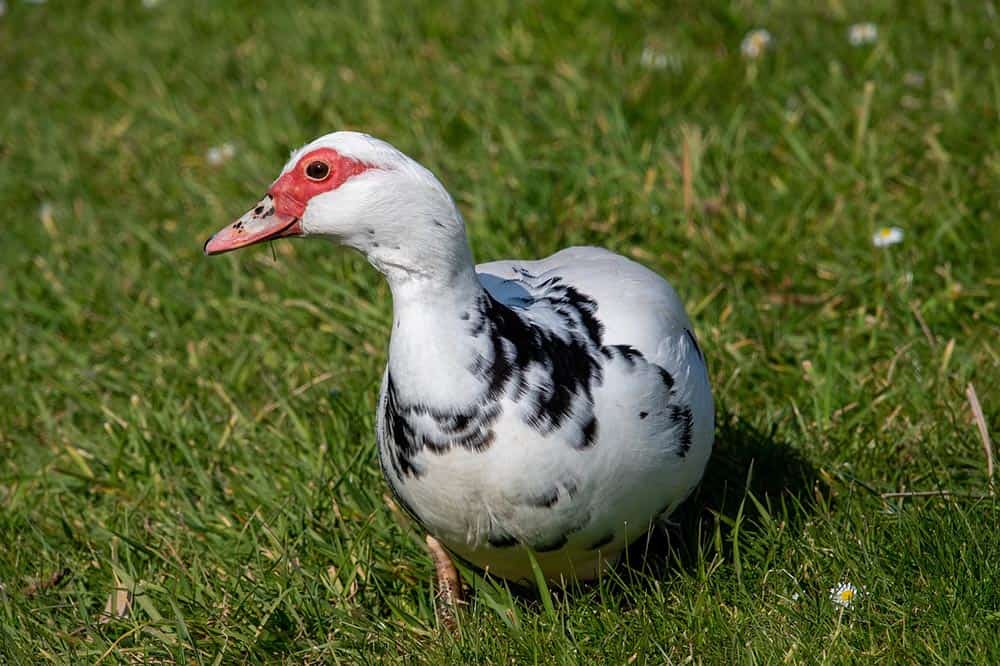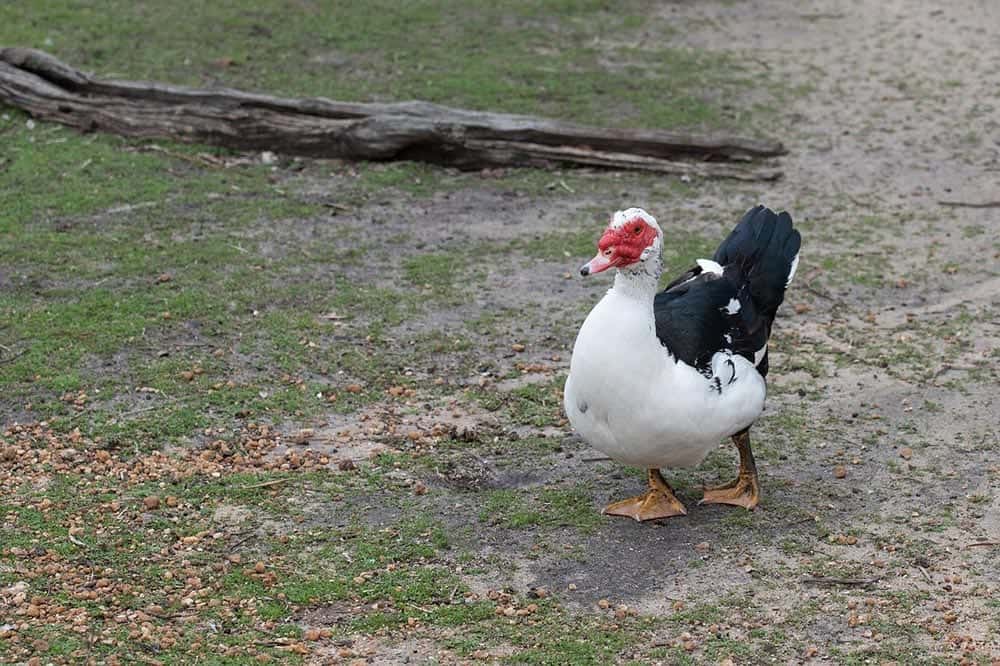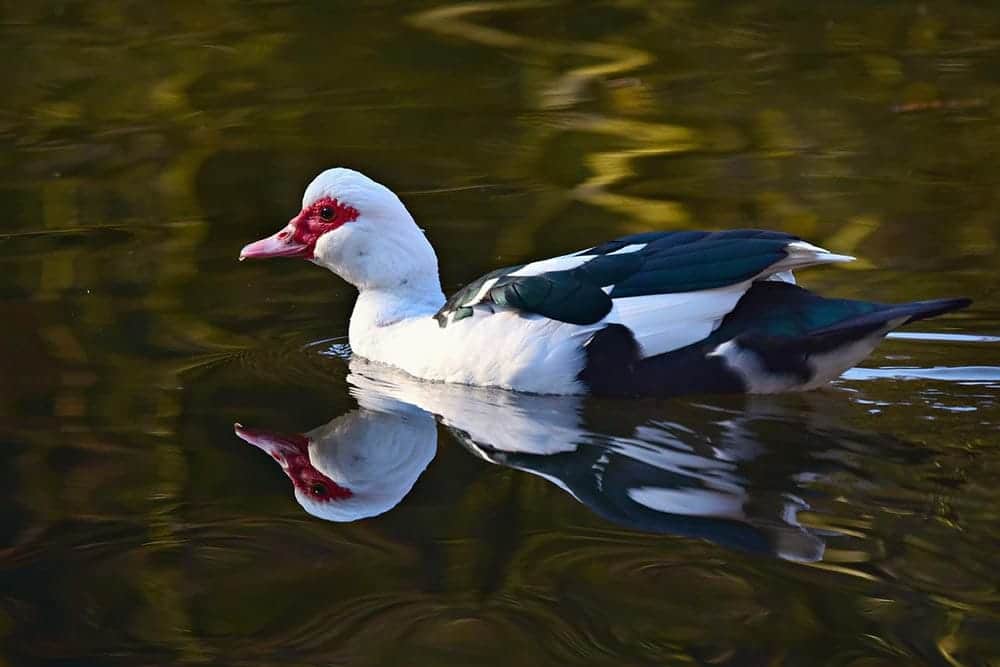Muscovy ducks are unique-looking ducks that are often mistaken as a breed of geese. They’re also commonly mistaken for having roots in Russia due to their name. However, they’re actually natives of the Americas.
These ducks are misunderstood in several more ways. So, we’re here to set the facts straight, clear up any confusion, and give these wonderful ducks the recognition they deserve.

Quick Facts About Muscovy Ducks
| Breed Name: | Muscovy duck (Cairina moschata) |
| Place of Origin: | Central America and South America |
| Uses: | Meat |
| Drake (Male) Size: | 28-33 inches |
| Hen (Female) Size: | 26-30 inches |
| Color: | Black, white, red |
| Lifespan: | 8-12 years |
| Climate Tolerance: | Hardy |
| Care Level: | Easy |
| Rarity: | Common |
Muscovy Duck Origins
The Muscovy duck got its name from a region of Russia near Moscow. However, this duck breed doesn’t come from Europe.
Muscovy ducks originate from the Americas and are most commonly found in South America and Central America. The domesticated species has been around for centuries and were raised by Native Americans.

Muscovy Duck Characteristics
Muscovy ducks are hardy ducks that can live in both hot and cold climates. Their versatility may explain why you can see feral populations in various parts of the world.
These birds tend to be pretty docile and easygoing when they don’t feel threatened. Domesticated Muscovy ducks are pretty friendly, but they’re not ones to enjoy being held or touched. They prefer human company at a distance but aren’t afraid to approach people that are familiar to them.
ducks may show signs of aggression and be territorial during mating season. They can act overprotective, especially when they’re nesting. Hens are typically good mothers and become broody. They clutch between 12 to 16 eggs, but they can care for up to 30 eggs at a time.
Muscovy ducks are grazers and typically eat grass and aquatic plants. They can also eat small fish, amphibians, crustaceans, and reptiles. They enjoy eating insects, so farmers can use them to keep grasshopper populations under control.
Wild Muscovy ducks can fly and prefer to roost in trees for the night. However, domesticated Muscovy ducks either can’t fly or don’t gain too much height.
Uses
Muscovy ducks are most often raised for their meat. The breast meat is very lean and the skin has less fat than other duck species. Muscovy duck meat is often described as tender and flavorful and is compared to roast beef and veal.
Despite being flavorful, Muscovy ducks aren’t the most popular for large-scale farming. They mature more slowly than other ducks, including the Peking duck. They also eat a lot, so they’re not the most efficient duck breed.
Muscovy duck eggs aren’t as popular as the meat. Hens can lay anywhere between 60-120 eggs per year, which is a pretty low number for ducks.

Appearance & Varieties
Muscovy ducks are a larger duck breed and often get compared to geese. They have long necks and bills. They typically have black and white feathers and a red face with warts. Some varieties can have deep green feathers on their back and wings. Female Muscovy ducks tend to have more muted colors compared to their male counterparts.
There are wild Muscovy ducks and domesticated ducks. Domesticated ducks tend to be larger and heavier than wild ducks.
Muscovy ducks can also be crossbred with Mallards. These hybrids are known as Mulards. Mulards are sterile and are raised for meat or foie gras. They mature faster than Muscovy ducks while maintaining a similar size as purebred Muscovy ducks.
Population/Distribution/Habitat
Muscovy ducks naturally live in tropical climates and live in forested wetlands, ponds, and lagoons. However, domesticated varieties are quite hardy and can handle living in colder temperatures.
While most Muscovy duck populations are found in the Americas, several feral populations also live in Hawaii, Australia, New Zealand, and some parts of Europe.
Partners in Flight¹ estimates a global population of 550,000 Muscovy ducks. These ducks don’t have too many conservation concerns. However, there have been sharp declines in flocks all over the world due to overhunting and destroyed natural habitats.

Are Muscovy Ducks Good for Small-Scale Farming?
Muscovy ducks aren’t the most ideal ducks for large-scale farming, but they can do well for some small-scale farmers. They’re hardy and docile, and they produce high-quality meat.
However, there are some factors to consider. First, some Muscovy ducks can fly and like to roost in elevated spaces. So, you’ll need to make accommodations for their roosting behavior.
Muscovy ducks are also not as efficient when compared to other domesticated ducks. They take a longer time to mature, and they eat a lot of food.

Conclusion
Muscovy ducks are unique ducks that have also been domesticated. They’re primarily raised for their meat. However, they’re not an efficient breed because they require a lot of feed and have a long maturity rate. They also don’t lay very many eggs throughout the year.
Therefore, while Muscovy ducks are favored for their meat, they’re not the most popular duck for industrial purposes. They’re hardy ducks that can become great backyard pets. They’re good-natured and aren’t easily startled by humans. As long as they have plenty of space to roost, they can live long and happy lives as pets.
Featured Image Credit: MabelAmber, Pixabay
